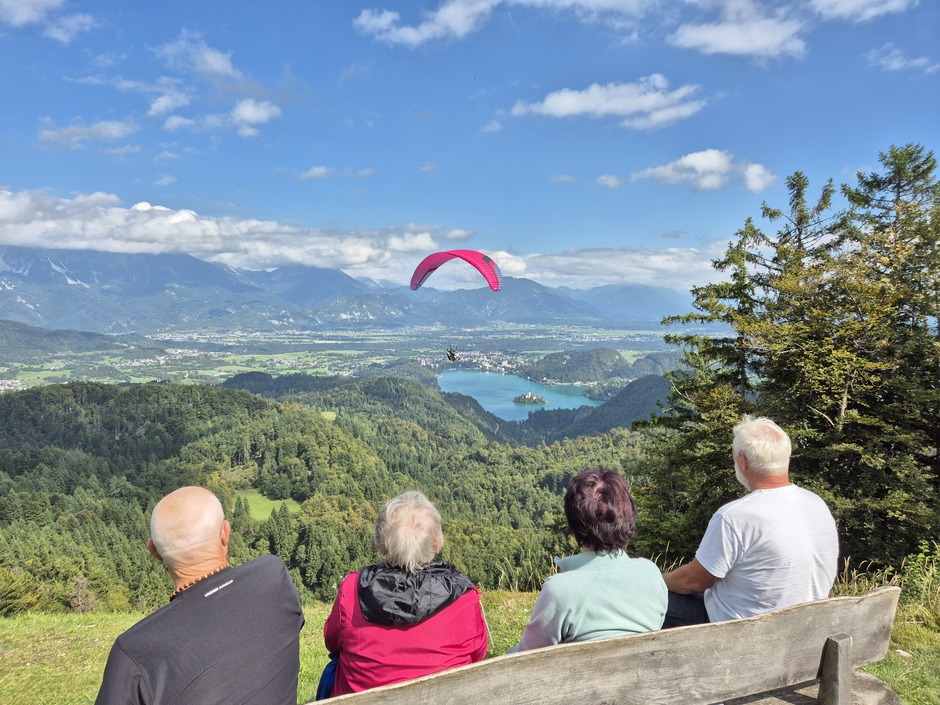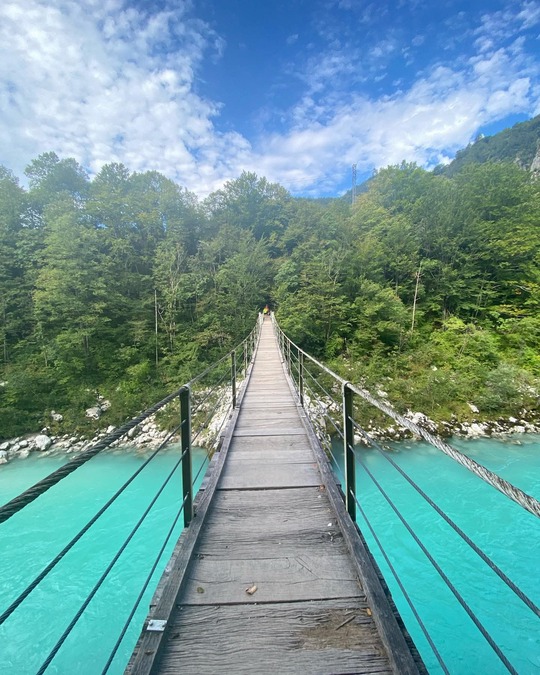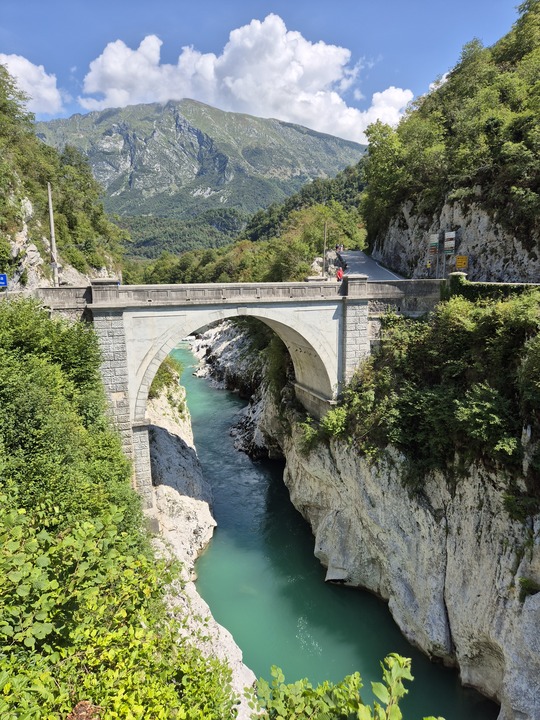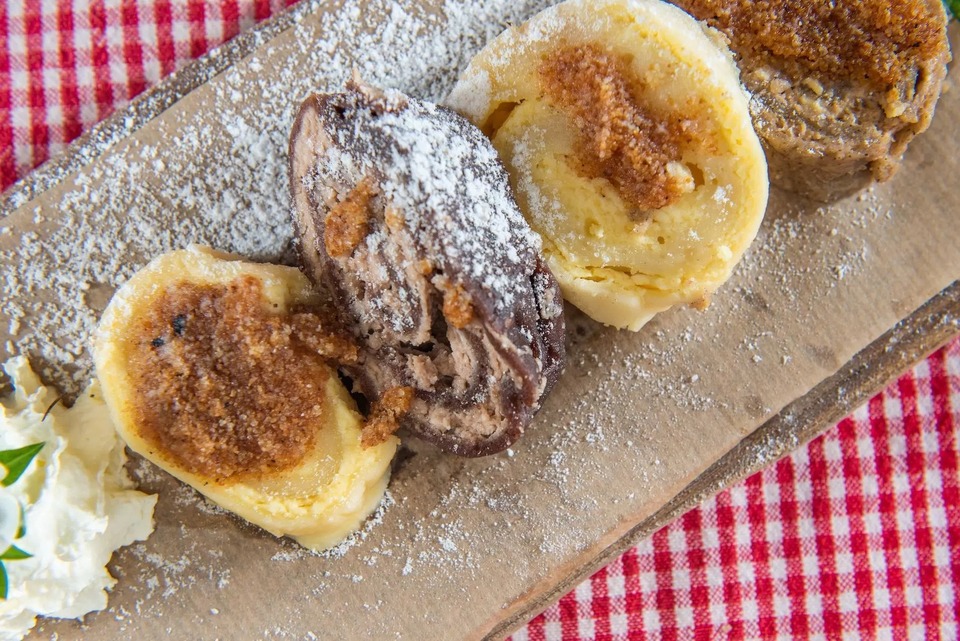CULINARY HIKING TOUR IN SLOVENIA
HIGHLIGHTS
Hike in the heart of the Triglav National Park
Enjoy the fantastic landscape of Lake Bled
Swim in Lake Bohinj
Admire the breathtaking views of the Julian Alps
Venture into the unspoiled Soča River Valley and explore Kobarid’s historic sites
Learn authentic Slovenian recipes and culinary traditions from local hosts
Taste the diverse traditional Slovenian food
Learn about wine production in Goriška Brda
Sample exceptional Slovenian wines, perfectly paired with delicious farm to table cuisine
Explore beginner friendly hiking trails on 8-day hiking adventure, feel the nature and taste traditional Slovenian food & wine in different regions. Enjoy the world-famous, picturesque Lake Bled and amazing glacial Lake Bohinj.
Enjoy the stunning Soča River Valley, one of the most beautiful river valleys in the world and visit the historic town of Kobarid - a blend of nature, history, and delicious food. Leave the mountain trails of Triglav National Park and walk into the vineyards of Goriška Brda. Taste some traditional local food and world-class wine. After delicious culinary delights in the countryside, end the trip in the vibrant capital city of Ljubljana.
Grab your hiking poles and join us on this unforgettable hiking and culinary adventure in Slovenia!
HOLIDAY ITINERARY:
DAY 1 – ARRIVAL IN LJUBLJANA
Arrive in Ljubljana, check into your room. Walk along the river banks and admire bridges, explore the historical city center and medieval old town, admire the stunning architecture, and walk around the colorful marketplace. Visit Ljubljana Castle and treat yourself to beautiful views of the city from the castle’s ramparts or Outlook Tower. Afterwards, there will be a welcome dinner with traditional Slovenian food.
Meals included: Dinner
Accomodation: Slamič B&B 4*

DAY 2 - DISCOVER LAKE BOHINJ
After breakfast, drive to Lake Bohinj, a peaceful alpine valley and hike in one of the most beautiful natural attractions in the heart of the Triglav National Park, Mostnica Gorge. From the panoramic trail along the riverbanks admire the incredible power of crystal clear water, which has been breaking through solid rock over the centuries and forming various pools and other natural attractions. Enter into the idyllic valley with beautiful meadows and shepherd houses and reach the waterfall. After hiking, time to relax by Lake Bohinj and swim in its fresh waters.
Meals: Breakfast, lunch, dinner
Distance: 6.8 miles (11 km)
Hiking: 3,5 hours
Elevation gain: +270m (885 feet), -270m (885 feet)
Accommodation: Hotel Center Pokljuka 3*

DAY 3 – HIKE ON POKLJUKA PLATEAU
Start hiking straight from your hotel and enter into the magical spruce forest which leads to Zajamniki mountain pasture, where cows still graze during the summer. It is known for its fabulously arranged old shepherd's huts, and offers one of the most beautiful views of the Julian Alps. Continue to Uskovnica plateau, enjoy unspoilt nature, alpine meadows and views that always fascinate. Taste traditional Slovenian food in the mountain hut and return back to the hotel, where you can catch the biathlons training for world famous biathlon competition on Pokljuka.
Meals: Breakfast, lunch, dinner
Distance: 8 miles (13 km)
Hiking: 4 hours
Elevation gain: +340m(1115 feet), -340m (1115 feet)
Accommodation: Hotel Center Pokljuka 3*

DAY 4 – LAKE BLED AND COOKING CLASS WITH LOCALS
Discover Lake Bled, a picture-perfect lake with its iconic island. Hike to a smaller hill that offers an incredible view of the medieval castle perched on the edge of a rocky cliff and surrounding mountains. Spice up your visit with a touch of adrenaline and take a ride on the sledding track. Take a scenic walk up to Bled Castle, enjoy the views and taste the local speciality, Bled custard cream cake. For lunch it is time to join the cooking class with locals where you will learn how to prepare traditional Slovenian food. Hands-on experience spiced up with Slovenian wine. Transfer to Kranjska gora, your next destination for 2 days.
Meals: Breakfast, lunch, dinner
Distance: 4.3 miles (7 km)
Hiking: 2,5 hours
Elevation gain: +250m (820 feet), -250m (820 feet)
Accommodation: Hotel Kranjska gora 4*

DAY 5 - KRANJSKA GORA AND LAKE JASNA
Hike along the Sava Dolinka River on a narrow, well-maintained path and enjoy nature. The trail leads to the picturesque village above Gozd Martuljek and rewards you with breathtaking views of the Julian Alps. Continue on to Lake Jasna, a turquoise lake surrounded by jaggy peaks, where you’ll have time to rest and enjoy lunch with the view on your own. Before dinner, stop on nature reserve Zelenci. The observation tower next to the lake offers a view of the emerald green lake from a higher perspective.
Meals: Breakfast, dinner
Distance: 9.3 miles (15 km)
Hiking: 4,5 hours
Elevation gain: +330m (1082 feet), -330m (1082 feet)
Accommodation: Kranjska Gora hotel 4*

DAY 6 – SOČA RIVER VALLEY
The scenic mountain road will take you into the stunning and unspoilt Soča River Valley. The day will be a blend of nature, history, and delicious food. First, you will have a scenic and pleasant walk to the lovely, hidden Kozjak waterfalls before visiting the historic town of Kobarid, where Ernest Hemingway was inspired to pen his novel, A Farewell to Arms. Continue a transfer along a route to Slovenia’s winegrowing region of Goriška Brda and marvel at the land of gently rolling hills covered with orchards and vineyards. After dinner with wine pairing you will tour the family's wine cellar. The owners will show you how they follow and nurture a centuries-old tradition of winemaking methods in addition to offering diverse, excellent certified organic wines.
Meals: Breakfast, dinner
Distance: 4.6 miles (7,5 km)
Hiking: 2,5 hours
Elevation gain: +260m(853 feet), -260m (853 feet)
Accommodation: Family run tourist farm – Hiša Štekar


DAY 7 - EXPLORE GORIŠKA BRDA AND WINE TASTING
After breakfast, an easy hike on Sabotin mountain. Since this area was also a strategic point during the First World War, you can see the preserved bunkers, ditches and caverns. At the top of the mountain admire the view of the emerald Soča River that winds towards the sea. Climb to the lookout tower at Gonjače, that offers magnificent views of the entire region and even the Adriatic coast and Slovenian highest mountain-Triglav. You will wrap up your tour by visiting Šmartno, one of the best preserved medieval villages in Slovenia. Then it is time to visit one of the best winemakers in the region and enjoy wine tasting with home made cold cuts. Before a farewell dinner with a selection of your host's wine you will have time to swim in the pool with a stunning view of Goriška Brda.
Meals: Breakfast, dinner
Distance hike 1: 2 miles (3,5 km)
Hiking: 1: 1 hour
Elevation gain 1: +120m(393 feet), -120m (393 feet)
Distance hike 2: miles ( 3 km)
Hiking 2: 50 min
Elevation gain 2: +70m (229 feet), -70m (229 feet)
Accommodation: Family run tourist farm – Hiša Štekar

DAY 8 - GOODBYE SLOVENIA
After breakfast, you will be transferred either to Ljubljana Airport or, if you’re keen on staying a bit longer, to your next accommodation in Ljubljana.
Meals: Breakfast
Notes on Itinerary
Although we do our very best to adhere to the schedule listed above, this itinerary is subject to change for numerous reasons beyond our control.
Trip dates:
2026
18 - 25 July
5 - 12 September
3 - 10 October
Price: 3.650 EUR per person based on double occupancy
Single supplement: 350 EUR
Activities: Hiking
Group Size: 4-8
Guide ration: 1 guide per 8 guests
Accommodations: Hotels/Tourist farm - 7 nights
Activity level: 2/5, This trip is beginner friendly. While it requires no hiking experience, make sure you are physically prepared for this trip. You should feel comfortable hiking the average 6.1 miles (10 km) per day and climbing some stairs. If you’re ready to keep up with the tempo, you’re good to go!
Guided Group
This is a small-group guided holiday. The group is usually 4 to 8 people, like-minded clients booking individually, as a couple or as friends together.
Price includes:
An English speaking, professional local mountain guide throughout the trip
Ground transportation throughout Slovenia as per the itinerary
All accommodations in 3 -, 4-star hotels/tourist farms (two people sharing a twin/double room), with private facilities
Meals as noted in the daily itinerary
Cooking class with locals on Lake Bled
3x wine tasting in Goriška Brda
All entrance fee
Day 8 - transfer to the Ljubljana
Tourist tax
Not included:
International airfare and airport taxes
Meals not specified in the itinerary
Drinks and alcoholic beverages
Travel insurance (highly recommended)
Optional gratuities for your guides
Personal expenses
Additional Information about the tour:
If you request single accommodations, you will be asked to pay the full single supplement fee. There are a limited number of single rooms available to request. If you wish to share accommodations, we will assign you a roommate if one is available. Please be advised that there are a limited number of single rooms available, and single rooms are not available at the mountain huts.






